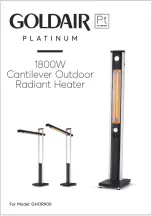
39
CAUTION:
Care is necessary when tightening fittings into the gas control or pressure regulator. The
gas control or pressure regulator casting may crack if the fittings are over tightened. Cracked castings
are not covered under warranty. Damaged gas controls and pressure regulators must be replaced.
GAS SUPPLY PRESSURE
The following maximum and minimum gas supply pressures apply:
Gas Type
Natural Gas
Propane
Minimum
Pressure (kPa)
1.13KPa
1.13KPa
Upstream gas pressure under full load
Maximum
Pressure (kPa)
2.6 kPa
3.2 kPa
Gas supply pressure set point under
load and no-load conditions
Table 14: Maximum and Minimum Gas Supply Pressures
If upstream pressure exceeds 3.5 kPa at any time, an appliance gas pressure regulator must be
installed. This regulator should be placed a minimum distance of 10 times the pipe diameter upstream
of the heater gas controls.
When connecting additional gas utilization equipment to the gas piping system, the existing piping must
be checked to determine if it has adequate capacity for the combined load.
The gas valve pressure regulator on the heater is nominally preset as noted in Table 15 on page 39.
MVB Model
Manifold Gas Pressure Setting
High Fire Values (kPa)
Nat. Gas
Propane
910500
-1.17
-1.32
910750
-1.15
-1.44
911000
-1.15
-1.87
911250
-1.57
-2.07
911500
-2.07
-2.69
911750
-1.12
-1.89
912000
-1.59
-2.59
Table 15: Manifold Gas Pressure Settings
During normal operation, carbon dioxide should be 9.0% ± 0.2% at full fire for natural gas and
10.2% ± 0.2% for propane gas. Carbon monoxide should be ‹100ppm at all firing rates, measured at
the test port, 300mm above the flue collar.
The heater and its gas connection must be thoroughly leak tested before placing in operation. Use
soapy water and a manometer to test for gas leaks.
DANGER!
Do not use an open flame to check for
gas leaks.
CAUTION
: For proper operation, no more than a 30% drop in gas supply pressure from no-load to full
load conditions is acceptable. Under no circumstances should the pressure be outside the listed
operational range.
CAUTION:
Do not use Teflon tape on gas line pipe thread. A pipe compound rated for use with natural
and propane gases is recommended. Apply sparingly only on male pipe ends, leaving the two end
threads bare.
CAUTION:
Support gas supply piping with hangers, not by the heater or its accessories. Make sure the
gas piping is protected from physical damage and freezing, where required.
















































